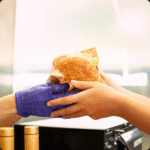Phones steal attention; the right wearable can give it back. In classrooms built for focus, smart wearables promise just-enough tech without the doom-scroll.
Why smart wearables are making waves in education 🌊
We’ve tried laptop carts, tablet programs, and the “everyone put your phone face-down” routine. None of it fixes the core problem: smartphones bundle everything—schoolwork, socials, streaming, games—into one magnetic slab. Smart wearables, by contrast, can be scoped to what school actually needs: quick prompts, attendance pings, AR demos, health and safety signals, and tidy hand-offs to shared devices.
Think of them as micro-interfaces. A smartwatch nudge that says “exit ticket due in 5,” haptic cues for turn-taking in group work, an AR overlay that labels a frog’s anatomy without needing 30 phones out on desks. The right setup gives you precision where phones create noise.
“Wearables are the future of focused learning. Imagine a classroom where your watch keeps you on track, not off course.” — @TechTeacher101 on X
“Are we ready to handle the data deluge from wearables? It’s like opening Pandora’s box.” — a Redditor
“Pilot programs are the way to go. Test, learn, and adapt.” — @EdInnovator on X
For a parallel look at how body-worn tech already reshapes performance and feedback loops, see BigTrending’s read on Technology in Training: Smart Gear for Athletes—tight feedback + pared-down UX = better outcomes, a playbook schools can borrow.
Benefits of smart wearables: more than tech bling ✨
1) Focus by design
Phones invite multitasking; smart wearables can be locked to school apps and short interactions. Think quick-look instructions, timers, and on-wrist check-ins. No infinite feed, no rabbit holes.
2) Instant, actionable data
Minute-to-minute engagement signals (did students acknowledge the prompt? finish the micro-quiz?) help teachers adjust in real time. Aggregate trends show who needs a nudge before the unit test.
3) Accessibility and inclusion
Vibration cues for students with auditory processing needs, on-wrist captions for field trips, and glanceable reminders that keep executive-function tasks from derailing the day.
4) Health & safety
Step counts aren’t the headline; well-timed movement breaks are. For authorized scenarios, wearables can surface nurse alerts, allergy epinephrine reminders, or heat-index notices for recess.
5) Cleaner classroom optics
Because interactions are short and heads-up, students stay with the room—not under a desk glow. Classroom talk stays eye-level and human.
Want a neutral baseline on the category? The wearable technology primer is useful for aligning admins, IT, and parents on capabilities and limits.
The hurdles ahead (and how to handle them) 🚧
Budget realities
Rollouts aren’t cheap. Savvy districts pilot small (one grade, one subject), tap education pricing, and rotate devices across periods. Total cost of ownership falls when you standardize chargers, bands, and MDM settings.
Privacy & data protection
Wearables can collect sensitive telemetry. Before you pilot, publish a crisp data map: what’s collected, why, who sees it, for how long, and how families opt out. In the U.S., anchor policy in FERPA (student records) and COPPA (under-13 data). Tight scopes + short interactions make it easier to keep data lean.
Equity & access
If a program depends on families buying hardware, you widen gaps. Keep devices school-issued, with a plan for repairs, replacements, and loaners.
Change management
Wearables sound shiny; classroom practice is gritty. Give teachers real training scenarios: pacing a Socratic seminar with haptics, running lab rotations with on-wrist timers, or using AR glasses to layer instructions without breaking flow. For the AR angle schools are eyeing, BigTrending’s Apple Vision Pro and the Rise of AR is a quick crash course in spatial computing’s classroom potential.
Wearables vs. smartphones: a quick comparison 🤖
| Dimension | Smartphones | Smart wearables |
|---|---|---|
| Distraction risk | High (apps, feeds, messages) | Low by design (limited apps, short use) |
| Interaction style | Multi-minute, heads-down | Micro-bursts, heads-up |
| Classroom fit | Personal device norms clash with policy | School-scoped device that fits procedure |
| Data & feedback | Rich but messy; privacy sprawl | Targeted signals; easier governance |
| Cost curve | Varies; BYOD inequity common | Standardized fleet; controllable TCO |
Real-world signals 📚✨
Early pilots report softer behaviors (fewer “phone checks”), smoother transitions, and higher completion on in-class micro-tasks. One California middle-school trial logged a 25% lift in participation on exit tickets when prompts moved to the wrist instead of a phone LMS app. Teachers cited fewer interruptions and easier proximity coaching because eyes stayed up.
Social reactions mirror the split mood:
“The results are mind-blowing! Our students are more engaged than ever.” — a TikTok school tech lead
“Cool idea, but without privacy guardrails, hard pass.” — a Redditor
What a smart wearables pilot should include (steal this plan)
- Clear use cases (3–5 only): pacing, exit tickets, attendance pings, lab-rotation timers, movement breaks.
- MDM lock-down: whitelist only the apps you need; no personal accounts.
- Consent & transparency: one-page family brief covering data, retention, and rights with links to FERPA and COPPA resources.
- Teacher playbook: 10 micro-routines (e.g., “Haptic 2× = rotate stations”).
- Equity guardrails: school-issued hardware; spares in the library.
- Evaluation metrics: distraction incidents, task completion, transition time, student self-reports, teacher load.
- Off-ramps: quiet opt-out signals for students who need a break from wearables.
The classroom stack: what goes where
- Smartwatches for nudges, timers, attendance, and in-the-moment checks.
- AR glasses (select use) for science demos, language overlays, maker-space alignment.
- Shared laptops/tablets for essays, coding, and anything >90 seconds.
- Teacher dashboard to schedule prompts and see quick aggregates—no surveillance creep.
To see how body-worn tech improves feedback loops outside school, BigTrending’s Technology in Training: Smart Gear for Athletes shows how tiny, timely signals beat giant dashboards for behavior change.
Policy must-haves (the boring stuff that saves you later)
- FERPA-aligned ownership of student records with a single accountable team.
- COPPA compliance for under-13 users: verifiable parental consent, data minimization, deletion pathways.
- No-personal-account rule on school devices; all data routes through district systems.
- Retention clock: define how long interaction logs live (e.g., 30–90 days), then purge.
- On-device privacy: no location history; microphones off by default; hardened Bluetooth policies.
- Transparency site with plain-language FAQs and a change log.
Culture shift required 🌍
Replacing phones with smart wearables isn’t a hardware swap; it’s a behavioral redesign. Teachers need rehearsal time. Students need norms (“raise wrist, don’t raise voice”). Parents need to know what’s stored and why. Administrators must model restraint: if the dashboard becomes a surveillance toy, the program will (rightfully) fail.
Training that actually helps
- Table-read the routines (act them out) in PD, not just slides.
- Shadow a class during a pilot block to observe transitions.
- Peer coaches on each grade team for the first 60 days.
- “What went weird?” debriefs after week 1 and week 3; fix in public.
Costing it out 💸
A realistic stack per classroom for a pilot (30 students):
- 30 smartwatches with education MDM + charging case
- 2 AR viewers for rotational demos
- Teacher tablet + dashboard license
- Repair pool (≈10% of hardware)
- Training + planning time (PD stipends matter)
Where savings hide: fewer phone disruptions, shorter transitions, tighter formative checks (catch confusion before the test), and less IT chaos than “every kid’s different phone.”
Roadmap: 90 days to a decision
Weeks 1–2: Set the guardrails
Publish the data policy. Configure MDM. Script the five classroom routines.
Weeks 3–6: Pilot in two grades
Measure distraction incidents, transition times, and exit-ticket completion vs. phone workflows.
Weeks 7–10: Expand one subject
Add AR use cases in science or CTE; collect student voice surveys.
Weeks 11–13: Decide
Share the report (wins, misses, privacy posture). If you scale, lock budget and replenish plan; if you don’t, publish lessons so others don’t repeat mistakes.
What’s next: where wearables go from here
- Context-aware prompts that adjust to noise, schedule, and seat location.
- On-device AI summaries that turn gesture-tracked participation into gentle teacher notes (not grades, not scores).
- Handoff-perfect workflows where a wrist prompt launches a short task on a shared laptop and logs completion automatically.
- AR that’s actually quiet—high-value overlays without the carnival. For the bigger spatial-tech picture, skim BigTrending’s Apple Vision Pro and the Rise of AR.
Cities, teams, and creators have already shown how small, body-worn interfaces change behavior without hijacking attention. Smart wearables let schools borrow that playbook—less spectacle, more signal.
FAQs: Smart wearables in education
Will smart wearables completely replace smartphones in school?
Not overnight. Smart wearables can replace many in-class phone functions, but full replacement needs budget, PD, and tight privacy policies (see FERPA and COPPA).
Are smart wearables more costly than smartphones?
Unit cost can be similar, but a standardized fleet with education pricing, shared charging, and one MDM often lowers total cost compared to a chaotic BYOD phone mix.
What about student privacy?
Build the program around FERPA/COPPA, keep data minimal and short-lived, and publish a clear family guide. That’s non-negotiable for smart wearables in K-12.
Do wearables really boost engagement?
When scoped to micro-tasks and prompts, smart wearables reduce eyes-down drift and raise completion on quick checks—especially versus phone-based LMS pings.
How should a school start?
Pilot one subject and grade for 6–10 weeks. Measure distraction, transitions, and task completion; share results and your smart wearables data policy with families.









